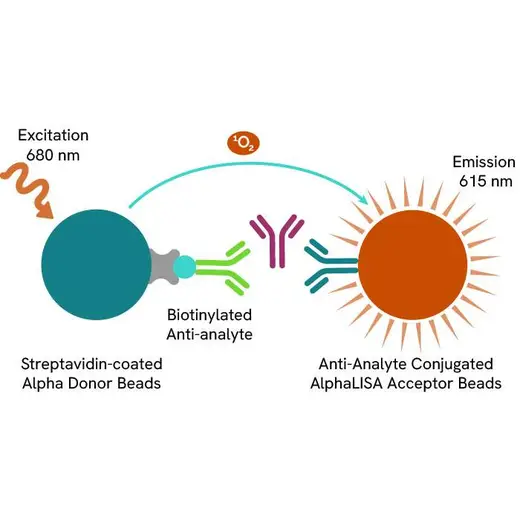
AlphaLISA Human BTLA Detection Kit, 100 Assay Points


 View All
View All
AlphaLISA Human BTLA Detection Kit, 100 Assay Points














The AlphaLISA™ immunoassay kit for human BTLA enables the quantitative determination of human B- and T-lymphocyte attenuator (BTLA, CD272) in serum, buffered solution, and cell culture media using a homogeneous AlphaLISA assay (no wash steps).
For research use only. Not for use in diagnostic procedures. All products to be used in accordance with applicable laws and regulations including without limitation, consumption and disposal requirements under European REACH regulations (EC 1907/2006).
| Feature | Specification |
|---|---|
| Application | Protein Quantification |
| Dynamic Range | 11 - 300,000 pg/mL |
| Limit of Detection | 11 pg/mL |
| Limit of Quantification | 38 pg/mL |
| Sample Volume | 10 µL |
The AlphaLISA™ immunoassay kit for human BTLA enables the quantitative determination of human B- and T-lymphocyte attenuator (BTLA, CD272) in serum, buffered solution, and cell culture media using a homogeneous AlphaLISA assay (no wash steps).
For research use only. Not for use in diagnostic procedures. All products to be used in accordance with applicable laws and regulations including without limitation, consumption and disposal requirements under European REACH regulations (EC 1907/2006).







AlphaLISA Human BTLA Detection Kit, 100 Assay Points







AlphaLISA Human BTLA Detection Kit, 100 Assay Points







Product information
Overview
Formats:
- Our 100 assay point kit allows you to run 100 wells in 96-well format, using a 100 µL reaction volume (10 µL of sample).
- Our 500 assay point kit allows you to run 500 wells in 96-well or 384-well format, using a 50 µL reaction volume (5 µL of sample).
- Our 5,000 assay point kit allows you to run 5,000 wells in 96-well or 384-well format, using a 50 µL reaction volume (5 µL of sample).
Features:
- No-wash steps, no separation steps
- ELISA alternative technology
- Sensitive detection
- Broad sample compatibility
- Small sample volume
- Results in less than 3 hours
- Half the time of an ELISA assay
AlphaLISA technology allows the detection of molecules of interest in buffer, cell culture media, serum and plasma in a highly sensitive, quantitative, reproducible and user-friendly mode. In an AlphaLISA assay, a Biotinylated Anti-Analyte Antibody binds to the Streptavidin-coated Alpha Donor beads, while another Anti-Analyte Antibody is conjugated to AlphaLISA Acceptor beads. In the presence of the analyte, the beads come into close proximity. The excitation of the Donor beads provokes the release of singlet oxygen molecules that triggers a cascade of energy transfer in the Acceptor beads, resulting in a sharp peak of light emission at 615 nm.
B- and T-lymphocyte attenuator (BTLA), also known as CD272, is a 35 kDa transmembrane protein that is expressed on Th1 cells, B cells and NK cells. BTLA's main function is to regulate T cell activation by acting as an inhibitor when interacting with HVEM, B7-H4 and TNF receptors. Deletion of BTLA results in the overproduction of T cells, especially CD8+ cancer specific memory T cells. Higher expression of BTLA is correlated to patients with lung cancer and sepsis. This kit is designed to detect and quantify the levels of BTLA in cell culture supernatant and serum.
Specifications
| Application |
Protein Quantification
|
|---|---|
| Automation Compatible |
Yes
|
| Brand |
AlphaLISA
|
| Detection Modality |
Alpha
|
| Dynamic Range |
11 - 300,000 pg/mL
|
| Limit of Detection |
11 pg/mL
|
| Limit of Quantification |
38 pg/mL
|
| Product Group |
Kit
|
| Sample Volume |
10 µL
|
| Shipping Conditions |
Shipped in Blue Ice
|
| Target |
BTLA
|
| Target Class |
Biomarkers
|
| Target Species |
Human
|
| Technology |
Alpha
|
| Therapeutic Area |
Oncology
|
| Unit Size |
100 Assay Points
|
Image gallery






AlphaLISA Human BTLA Detection Kit, 100 Assay Points






AlphaLISA Human BTLA Detection Kit, 100 Assay Points






Video gallery

AlphaLISA Human BTLA Detection Kit, 100 Assay Points

AlphaLISA Human BTLA Detection Kit, 100 Assay Points

Resources
Are you looking for resources, click on the resource type to explore further.
Advance your autoimmune disease research and benefit from Revvity broad offering of reagent technologies


How can we help you?
We are here to answer your questions.






























